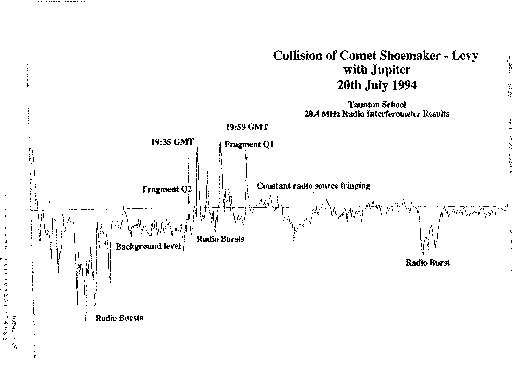
Tauton Radio Observatons of Fragment Q Impacts

NOTE: Click on the image to view it at its highest resolution.
Results of SL9 collisions using a 20.4 MHz radio interferometer
Taunton School, Physics Dept, Somerset, UK.
Trevor Hill (Head of Physics)
Pupils: Kathy Guernsay, Mathew Lang, Piers Williams, Elliot
Williams, K. Lawson, Christopher Mead, Willaim Everitt.
Observations and results
- Approx 1 hr before impact, radio bursting, peaks up to
6e-22 W/Hz/m2.
- During impact, radio bursting, peaks 10e-22 W/Hz/m2
or less
- For at least 2 hrs after impact, constant radio emission, 5e-23
W/Hz/m2 or less, until Jupiter out of beam of the interferometer.
This 3 part pattern observed for fragment A,H and Q under good
atmospheric conditions. We are interested if anyone can confirm
these results.
Systems calibrated against 3 observations of Cass A.
For more details FAX +44 (0)823 336054.
System Details
System used: Phase switched Interferometer
Frequency: 20.4MHz, Scanning within +/- 100kHz of main frequency
Switching frequency: 360Hz
Aerials: 2x2 elements, tuned Yagis for 20.4MHz, capture area
60 square meters, 35 feet up scafold towers.
Baseline: geographic E-W, 220meters
Aerial Elevation both 25 degrees (due South, geographic)
System time constat = 15secs
Output typically +/- 0.4V noise level.
System sensitivty (theoretical) 3e-23 W/Hz/m2
System bandwidth = 10kHz
Typical system gain = 140dB
recording mechanism - BBC computer (Archimedes) + chart recorder
 Images, Images, Images
Images, Images, Images



